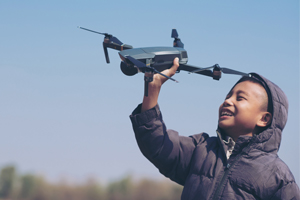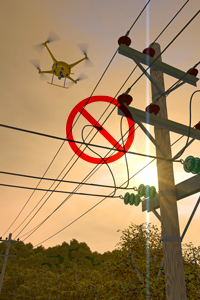
Drone Safety-SMART!
Whether you are new to drones or have lots of experience with them, knowing how to fly a drone safely is critical. Learn how to keep your drone from interfering in electric power lines and substations, and what to do if a drone goes where it shouldn’t.
You are the pilot of your drone
Just as an airplane pilot must keep his or her passengers safe, you must keep your drone safely away from areas where it could cause harm.
It is especially dangerous to fly drones near electric power lines, substations and power plants.
 A drone that hits a high-voltage power line, transformer, or other electrical equipment can cause a power outage. Not only that, electricity from the lines or equipment can make the drone so hot it catches fire. From there, the fire can spread to nearby trees or buildings.
A drone that hits a high-voltage power line, transformer, or other electrical equipment can cause a power outage. Not only that, electricity from the lines or equipment can make the drone so hot it catches fire. From there, the fire can spread to nearby trees or buildings.
So always fly your drone in open areas, far away from power lines, substations and power plants.
This is extra important if it is windy. Drones are lightweight, and even if you think you’ve got one under control, gusts of wind can take your drone off course. Assume all overhead lines are energized and potentially dangerous. Keep yourself and your drone at least 100 feet away from overhead power lines.
Remember: You are the pilot and are in charge of keeping everyone safe while flying your drone.
Follow the Rules of the Sky
 The Federal Aviation Administration (FAA) is a United States government agency that sets and enforces rules for pilots. As the pilot of your drone, you must follow the FAA’s rules of the sky:
The Federal Aviation Administration (FAA) is a United States government agency that sets and enforces rules for pilots. As the pilot of your drone, you must follow the FAA’s rules of the sky:
- Drones weighing more than 0.55 pounds must be registered with the FAA. You must be at least 13 years old to register your drone. If you are under 13, a responsible adult must register in your place.
- To register your drone, visit faadronezone.faa.gov. Flying an unregistered drone is a crime and can result in large fines!
- If your drone is under 55 pounds and you are flying it for purely recreational (enjoyment) purposes, you are encouraged to take and pass The Recreational UAS Safety Test or TRUST, which the FAA provides at this link: https://www.faa.gov/uas/recreational_flyers/knowledge_test-updates. It provides educational and testing for recreational flyers on important safety and regulatory information.
- Always keep your drone in sight.
- Do not fly near or over sensitive infrastructure or property. This includes electric power lines, substations and power plants, wind turbines, water treatment facilities, utility poles, trees, people, other aircraft or areas within 5 miles of an airport.
- Do not fly near or over a wildfire. It’s against the law and firefighting aircraft could be grounded, disrupting time-critical firefighting efforts. Unauthorized drone flights near wildfires face civil penalties totaling more than $20,000.
- Do not fly after dark.
- Never fly higher than 400 feet.
- Do not fly in adverse weather conditions, such as high winds or reduced visibility.
- Do not interfere with emergency response or law enforcement.
Do not treat your drone as a toy or fly it recklessly. It is capable of causing damage and destruction if you crash it into utility poles, electric power lines or trees near power lines.
Avoid the No-Drone Zone
 Experienced pilots use a checklist before they fly so they don’t forget any safety rules. Here is your No-Drone Zone checklist for safe flying:
Experienced pilots use a checklist before they fly so they don’t forget any safety rules. Here is your No-Drone Zone checklist for safe flying:
- ✓ Always fly your drone in an open area where you can clearly see your drone and your sightlines.
- ✓ Never fly in adverse weather conditions, such as high winds or reduced visibility or during thunder or lightning.
- ✓ Keep your drone away from trees and people.
- ✓ Never fly your drone over or into any of these:
-
- Electric power lines
- Utility poles
- Electric substations
- Water treatment facilities
- Wind turbines
- Within 5 miles of an airport
- Other aircraft
- Near or over any fire.
- Power plants
- ✓ Do not fly after dark.
- ✓ Never fly higher than 400 feet.
If Your Drone Goes Where It Shouldn’t
If your drone goes into any No-Drone Zone facilities, do NOT try to retrieve it! Tell an adult immediately, and call 911 and {Utility Name} at {XXX-XXX-XXXX} to report the incident. Give your address and the nearest cross street if you are asked for it.
If your drone gets stuck on a utility pole or line or inside a substation or power plant, move at least 100 feet away from the area and warn others to move away as well.
If your drone has caused an electric power line to fall to the ground, stay very far away! Even if they are not sparking or humming, fallen power lines can harm anyone who touches them or the ground nearby. Call 911 and {Utility Name} at {XXX-XXX-XXXX} to report the fallen line.
